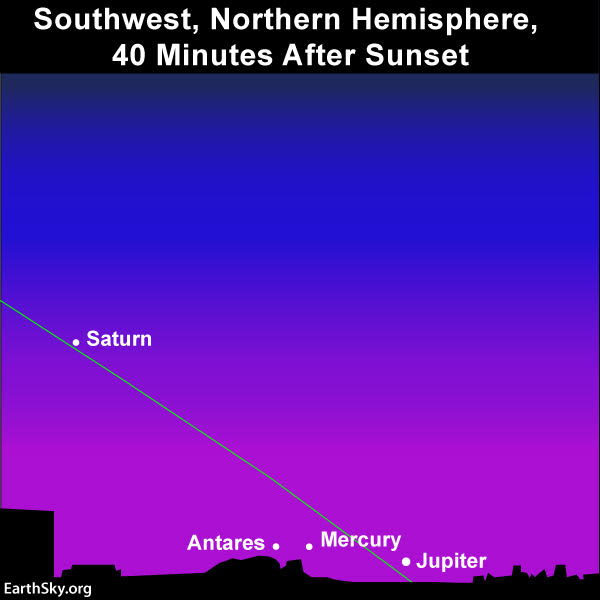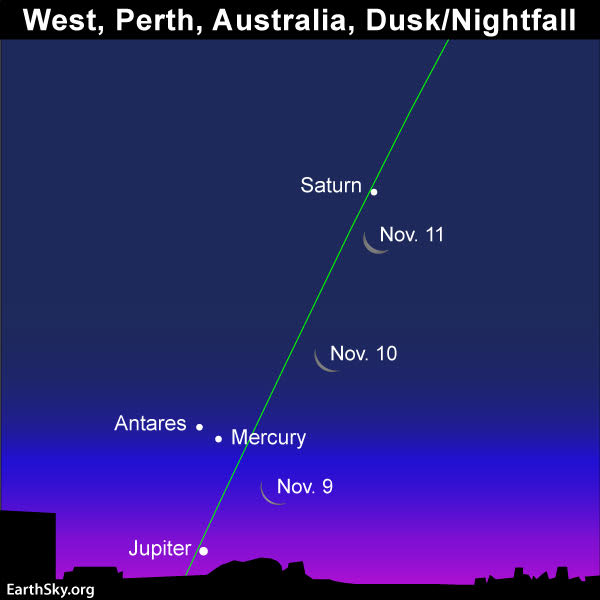
Today – November 6, 2018 – the planet Mercury reaches its greatest eastern elongation, that is, its maximum angular separation of 23 degrees from the setting sun for this evening apparition. As seen from the whole Earth, Mercury entered the evening sky (at superior conjunction) on September 21, 2018, and it’ll leave it (at inferior conjunction) on November 27, 2018.
The 2019 lunar calendars are here! Order yours before they’re gone. Makes a great gift.

Not to scale. An inferior planet – a planet that orbits the sun inside of Earth’s orbit – appears in the evening sky at its greatest eastern elongation, and in the morning sky at its greatest western elongation. The 2 inferior planets are Mercury and Venus, residing at a mean distance of 0.387 and 0.723 astronomical units from the sun, respectively.
It’s the same distance from the sun, on the sky’s dome, for all of us. Yet whether you see Mercury easily or not will depend on where you are on the Earth’s globe. Which hemisphere sees it better? Notice that our chart at top is set for the Southern Hemisphere, and notice that the ecliptic – or path of the sun, moon and planets across our sky – makes a steep angle with the evening horizon, as shown on the chart above.

Peter Lowenstein from Mutare, Zimbabwe (20 degrees south latitude) managed to catch Mercury in between the star Antares (top) and the planet Jupiter (bottom) 40 minutes after sunset on November 5, 2018. Thank you Peter!
That steep ecliptic angle will make Mercury much easier to see from southerly latitudes on Earth’s globe than from our latitudes in the Northern Hemisphere. Contrast the sky chart (and photo) for the Southern Hemisphere above with the sky chart (and photo) below for mid-northern latitudes in the Northern Hemisphere.

From northerly latitudes, like those in the U.S. and Europe, it’ll be much harder to spot the planets Mercury and Jupiter, plus the star Antares, after sunset.
The feature chart at the very top shows the western sky for one hour after sunset for around 30 degrees south latitude (South Africa, southern Australia). From these southerly latitudes, you even have a good chance of spotting the king planet Jupiter below Mercury and the bright star Antares above Mercury. But, even for this part of the world, you’ll want to find an unobstructed horizon in the direction of sunset to view these bright beauties popping out as dusk gives way to darkness. Jupiter is the brightest of the threesome, followed by Mercury and then the 1st-magnitude star Antares.
At 30 degrees south latitude, given an unobstructed western horizon, Jupiter will set about one hour after sunset, Mercury nearly two hours after sunset and Antares over two hours after sunset.

Kudos to Gary P. Caton, who managed to catch the star Antares (left), plus the planets Mercury (center) and Jupiter (right) after sunset November 3, 2018. View from Cowee Mountains overlook on the Blue Ridge Parkway (near Waynesville, North Carolina). Thank you Gary! Used with permission. Copyright © 2018 Gary P. Caton -all rights reserved ®.
Meanwhile, at 40 degrees north latitude (such as at Philadelphia, Pennsylvania), Jupiter will set about 50 minutes after sunset whereas Mercury and Antares will set about one hour after the sun. It’ll be much harder to spot this threesome at northerly latitudes than in the Southern Hemisphere or the northern tropics.
If you want to give it a try anyway, be sure to bring along binoculars! Use them to scan along the horizon. If you spot the planets, you can remove the binoculars and try to see them with the eye.
Click here for a recommended almanac giving you the setting times for the sun, Jupiter, Mercury and Antares in your sky.
By the way, southerly latitudes will also enjoy a better view of the young waxing crescent moon pairing up with these two bright planets and Antares on or near November 9, 2018. The sky chart below is for Perth, Western Australia, but you can click here to find out when the sun, moon, Jupiter, Mercury and Antares set in your sky.

Live in the Southern Hemisphere? Given an unobstructed horizon in the direction of sunset, you have a good chance of catching the young waxing crescent moon near the planets Mercury and Jupiter.
Bottom line: On November 6, 2018, Mercury reaches its greatest eastern elongation from the sun. Those at southerly latitudes are more likely to spot Mercury (plus nearby Jupiter and Antares) as dusk deepens into nightfall.
from EarthSky https://ift.tt/2JIJjFP

Today – November 6, 2018 – the planet Mercury reaches its greatest eastern elongation, that is, its maximum angular separation of 23 degrees from the setting sun for this evening apparition. As seen from the whole Earth, Mercury entered the evening sky (at superior conjunction) on September 21, 2018, and it’ll leave it (at inferior conjunction) on November 27, 2018.
The 2019 lunar calendars are here! Order yours before they’re gone. Makes a great gift.

Not to scale. An inferior planet – a planet that orbits the sun inside of Earth’s orbit – appears in the evening sky at its greatest eastern elongation, and in the morning sky at its greatest western elongation. The 2 inferior planets are Mercury and Venus, residing at a mean distance of 0.387 and 0.723 astronomical units from the sun, respectively.
It’s the same distance from the sun, on the sky’s dome, for all of us. Yet whether you see Mercury easily or not will depend on where you are on the Earth’s globe. Which hemisphere sees it better? Notice that our chart at top is set for the Southern Hemisphere, and notice that the ecliptic – or path of the sun, moon and planets across our sky – makes a steep angle with the evening horizon, as shown on the chart above.

Peter Lowenstein from Mutare, Zimbabwe (20 degrees south latitude) managed to catch Mercury in between the star Antares (top) and the planet Jupiter (bottom) 40 minutes after sunset on November 5, 2018. Thank you Peter!
That steep ecliptic angle will make Mercury much easier to see from southerly latitudes on Earth’s globe than from our latitudes in the Northern Hemisphere. Contrast the sky chart (and photo) for the Southern Hemisphere above with the sky chart (and photo) below for mid-northern latitudes in the Northern Hemisphere.

From northerly latitudes, like those in the U.S. and Europe, it’ll be much harder to spot the planets Mercury and Jupiter, plus the star Antares, after sunset.
The feature chart at the very top shows the western sky for one hour after sunset for around 30 degrees south latitude (South Africa, southern Australia). From these southerly latitudes, you even have a good chance of spotting the king planet Jupiter below Mercury and the bright star Antares above Mercury. But, even for this part of the world, you’ll want to find an unobstructed horizon in the direction of sunset to view these bright beauties popping out as dusk gives way to darkness. Jupiter is the brightest of the threesome, followed by Mercury and then the 1st-magnitude star Antares.
At 30 degrees south latitude, given an unobstructed western horizon, Jupiter will set about one hour after sunset, Mercury nearly two hours after sunset and Antares over two hours after sunset.

Kudos to Gary P. Caton, who managed to catch the star Antares (left), plus the planets Mercury (center) and Jupiter (right) after sunset November 3, 2018. View from Cowee Mountains overlook on the Blue Ridge Parkway (near Waynesville, North Carolina). Thank you Gary! Used with permission. Copyright © 2018 Gary P. Caton -all rights reserved ®.
Meanwhile, at 40 degrees north latitude (such as at Philadelphia, Pennsylvania), Jupiter will set about 50 minutes after sunset whereas Mercury and Antares will set about one hour after the sun. It’ll be much harder to spot this threesome at northerly latitudes than in the Southern Hemisphere or the northern tropics.
If you want to give it a try anyway, be sure to bring along binoculars! Use them to scan along the horizon. If you spot the planets, you can remove the binoculars and try to see them with the eye.
Click here for a recommended almanac giving you the setting times for the sun, Jupiter, Mercury and Antares in your sky.
By the way, southerly latitudes will also enjoy a better view of the young waxing crescent moon pairing up with these two bright planets and Antares on or near November 9, 2018. The sky chart below is for Perth, Western Australia, but you can click here to find out when the sun, moon, Jupiter, Mercury and Antares set in your sky.

Live in the Southern Hemisphere? Given an unobstructed horizon in the direction of sunset, you have a good chance of catching the young waxing crescent moon near the planets Mercury and Jupiter.
Bottom line: On November 6, 2018, Mercury reaches its greatest eastern elongation from the sun. Those at southerly latitudes are more likely to spot Mercury (plus nearby Jupiter and Antares) as dusk deepens into nightfall.
from EarthSky https://ift.tt/2JIJjFP

Aucun commentaire:
Enregistrer un commentaire